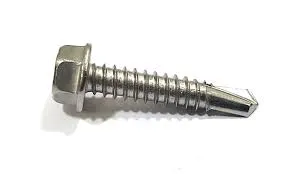What is a Self-Tapping Screw?
A self-tapping screw is a screw that can tap its own hole as the screw is driven into the material. It is a specific type of thread-cutting screw that produces a thread in a relatively soft material or sheet materials.
Bluntnose and flat-ended self-tapping screws require a pilot hole that is smaller than the screw diameter that needs to be created before they can be driven into the material by the screwdriver.
Pointed nose self-tapping screws do not require a pilot hole. Self-tapping screws are primarily used to secure wood, plastic, metal, and bricks together.
What is a Self-Drilling Screw?
A Self Drilling Screw is a type of self-tapping screw that also has a drill point. The sharp drill point of the self-drilling screw will both drill a hole and form the mating threads in a single operation.
The sharp drill point acts as a drill bit and the sharp cutting threads tap the hole during installation. The self-drilling screws are a commonly used variety of screws for quick drilling into metal as well as wood.
Self-drilling screws can easily be identified with their sharp flute or notch like tip.
Difference Between Self-Tapping and Self-Drilling Screws?
Self-tapping and self-drilling screws are two types of screws that are used in metal building and general construction, as well as in different industries. However, the two terms are not interchangeable.
The differences between a self-tapping screw and a self-drilling screw are:
- Screws that have sharp threads and that can carve into materials are known as self-drilling screws. In contrast, self-tapping screws require an initial pilot hole before the fastening process can begin.
- Self-drilling screws work as both a drill bit and a fastener. The self-drilling screws do not need a pilot hole because of the drill bit end. Self-tapping screws tap their own thread and thus they need a pilot hole that is smaller than the diameter of the screw.
- Self-tapping screws are used for securing thinner sheet metals and other substrates that cut their own threads. Self-drilling screws self-drill through various gauges of metal materials without any pre-drilling.
- Self-tapping screws are used to fix metal brackets into ply and timber. Self-drilling screws are used for cladding and metal roofing.
-
Nylon Hex Head Self Drilling Screw
How can you tell if a screw is self-tapping?
Screws can be distinguished if they are self-tapping or self-drilling. A self-tapping screw taps its own thread, thus they need a pilot hole that is slightly smaller than the diameter of the screws.
A pilot hole should be drilled into the wood or some softer material and then the tapping screw is driven into it. The threads will dig into the material and will keep it secured.
Conclusion
They offer a wide range of screws that will cater to your needs.
You can also visit their website and get information regarding the products they offer.


